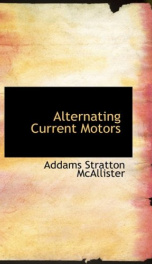alternating current motors

PREFACE TO THE THIRD EDITION. A comparison of the present edition with the second edition of this book will show that the essential features of the recently developed split-pole variable-ratio synchronous converter are discussed in the simplest possible terms, there has been added a chapter on Synchronous Motors, in which all of the characteristics of this machine both as a motor and as a condenser are fully treated, and the chapter on the Prevention of Spark ing in Single-Ehasc Commutators Rlotors has been expanded to include the recent improvements in commutating-pole motors. Throughout the whole book an effort has been made to dis tinguish between electrical-time degrees electrical space degrees and mechanical-space degrees. The importance of making such a distinction will be appreciated when one con siders the uncertainty and confusion that must be produced in the mind of a person unfamiliar with the facts when he is told that in a certain multipolar machine two fiuxes are in quadrature. The fact that many m-riters do not distinguish betaeen the three different angIes has caused the author to lay particular emphasis on these distinctions, in order to remove any confusion that may already exist in the mind of the reader. The book has been written and revised exclusively for the reader,-and the particuIar reader for whom the book is in tended is assumed to possess a fair general idea of electromagnetic phenomena and wishes to acquire specific information concerning the various types of alternating-current motors. In selecting the methods of presentation, choice has been made of the treatments vhich serve to impart the maximum of information with the minimum of confusion. As one rcviever has aptly stated, The general method of treating all motors is first to outline the theory roughly, leaving out the less important factors, and then to go through again putting in the details. For example, in Chap. XIII the physical phenomena involved in the operation of single-phase commutator motors are treated in the simplest possible manner with0u. t any reference to the me chanical dimensions or the electrical constants in Chaps. XIV and XV, hotvever, these mators are discussed in detail and the exact relation betm7cen the several parts of each machine is treated both algebraically and graphically. The phenomena of induction motors are dealt with separately in Chap. 11, Chap, VI, Chap. V111 and Chap. IX. To one thoroughly familiar nith the characteristic performance of induction motors, it might seem that these four chapters contain a considerable amount of repetition. The reader who is using the book as the source of his first information concerning the motors, hom-ever, l11 find that in Chap. 11 the entire treatment is concentrated on the secondary circuit, the modifying influences of the primary quantities being temporarily ignored the secondary circuit is considered as it actually exists-a combination of a constant resistir zca and a variable reactance. In Chap. V1 it is shown that, in its effect upon the primary quantities, the secondary circuit may be considered as composed of a constant eactance and a varzdl reszstanzg, and the primary and secondary quantities are combined and treated graphically see Fig. 35 by a method whose most prominent characteristic is its simplicity. Chap. V111 gives a rigorous discussion of the operation of induction motors, shorn-s how to construct an accurate current locus of the machine Fig... --This text refers to an alternate Paperback edition.
Info about the book
Author:
Series:
Unknown
ASIN:
B005LBUKW6
Rating:
4.5/5 (1)Your rating:
0/5
Languge:
English
Users who have this book
Users who want this book
What readers are saying
What do you think? Write your own comment on this book!
write a commentif you like alternating current motors try:
Other books by this author
Do you want to exchange books? It’s EASY!
Get registered and find other users who want to give their favourite books to good hands!



